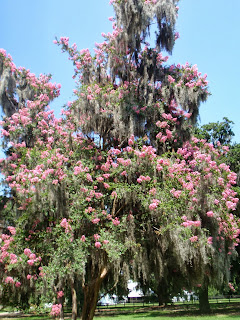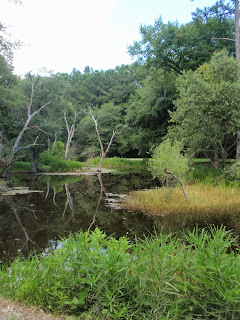BOONE HALL PLANTATION
Who says you can't have fun by yourself?
I've discovered that when I invite people and they
can't come or have to cancel I don't mind because I
enjoy exploring places by myself.
I had so much fun at the Boone Plantation.
Earliest known existence 1681
It was a HOT humid day but enjoyed walking around
these historic grounds. Feeling apart of History
and learning more about the beautiful South.
As soon as I parked I heard the thunder
and saw the dark clouds.
I grabbed my umbrella and people looked
at me with weird eyes but I came prepared.
The clouds went the other way and
I had a great walking stick.
NBC daytime television says
"A must see stop on any trip to SC"
I'm discovering I need to keep a small notepad
to record my thoughts and knowledge
on these little adventures because as time passes I tend to forget
about these beautiful experiences and days in my life.
I met a nice man all the way from New Zealand
to see the Boone Hall plantation.
He gaves me some tips on renting an RV
and traveling the states.
First owner was William H. McRae
which was developed into 4,039 acres.
First products Indigo/Cotton
The Cotton Mill
It use to serve as a dinner Hall and Wedding receptions.
Recently the building has been condemed and is on the
United States Historic registry.
Commissionary Building
Where workers from the 1800s went to receive
their pay and buy supplies.
Currently serves as the tour house.
Signed up for the theatre and tour of the house.
The Pecan Tree is a large deciduous tree.
A pecan, like a fruit of all other members of the hickory genes,
is not truly a nut, but is technically a drupe, a fruit with
a single stone or pit, surrounded by a husk.
The seeds of the pecan are edible, with a rich, buttery flavor.
They can be eaten fresh or used in cooking, in sweet desserts,
but also in savory dishes.
One of the most common desserts
with the pecan as a central ingredient is the pecan pie,
a traditional Southern U.S. recipe.
Pecans are also a major ingredient in praline candy,
most associated with New Orleans.
In addition to the pecan seed, the wood is also used in making
furniture and wood flooring as well as flavoring fuel
for making smoking meats.
End of 1800s Boone Hall Plantation was one of the
largest producers of Pecan in the United States.
Mansion
View of the house from the road.
" Black History in America"
Story is told using eight of the original slave cabins
located in a row. Each of the cabins
on slave street present different themes in telling the
Black History Story.
Slave Cabins
Cabin 1- Praise House
Cabin 2- Slave Crafts
Cabin 3- Their life and family
Cabin 4- Archaeological discoveries
Cabin 5- Their work and life
Cabin 6- Emancipation and Freedom
Cabin 7-Struggle for Civil Rights
Cabin 8- Heroes and leaders
In 1740 the plantation had forty slaves
The cabins were lived in til 1940s.
The view from inside the cabins
Quilts
Anyone that really knows me will
understand my thrill for African quilts.
Translations because the print is small
and I loved the idea of putting secret messages in quilts.
(The salves used their African designs in the applique
quilts that they made and the sense of color and style in
their pieced quilts was also inspired by African tradition.
A slave might be given a blanket once every three years,
quilts were a necessity. These women knew from their
mothers how to make vegetable dyes and could turn rough
slave cloth into every color of the rainbow. They used
worn clothes and scraps from the mistress of the house.
Few of these quilts survived, they were used until
wore out. As the abolitionist movement grew in the North
quilts were sold to raise money for the abolitionist cause.
The story that some patterns in quilts were used to pass
secret messages in the underground railroad network
remains uncertain, however the legend has now become
part of American History.)
Loved this tree I could look at it all day long.
In the 1850s the plantation was producing 4,000,000 bricks a year.
Doing the brick work were 85 slaves.
Came just in time for the last show on African History
Waiting to learn more about African History.
The presenter was much better at telling the story.
Slavery started in the Carolinas because crop owners
wanted to grow rice but didn't know how.
With some failed attempts they discovered
Africans had been growing rice successfully
for many generations. So that's when
investors started bringing Africans over on boats.
Also learned that slaves began trying to escape.
If they could make it to Florida to an indian tribe
they could be free. Most would never make it
and would be caught before they made it to
the destination. The slaves would speak
to each other with hidden secrets in singing
and playing the drums.
The Docks
The plantation holds wedding receptions on these docks
In 1936, Thomas Stone completed a packing house
and Wharf along Boone Hall Creek.
The building was destroyed during Hurricane Hugo
in 1989 and has since been replaced.
In 1743, son of major John Boone planted live
oak trees, arranging them in two evenly spaced rows.
Many brides love to have photos taken on this
road. I can see why it's stunning.
The plantation began giving tours of the mansion in 1959.
The current house on the property was built by Thomas Stone in 1936.
The house that was there was torn down.
The new house was built in he Colonial Revival Style.
Thomas Stone used bricks that was left on plantation
in the construction of his house.
The house is a three story with a full basement and measures about
10,000 ft. unlike original plantation houses the new house has a full sized
kitchen in the house along with seven bathrooms.
The first floor houses the kitchen, library, dining room, loggia and game room.
Second floor has seven bedrooms, third floor has two rooms,
a bathroom, and full size attic.
I took a tour of the house. We were only allowed
to see the first floor because the plantation owner aunt
comes to visit she stays on the second floor.
I wasn't allowed to take any photos inside the home.
You'll just have to come visit Charleston to see for yourself.
Only eight mile drive in the country.
The Gardens
Two Gardens
Brick-lined pathways create a butterfly pattern.
Sections closest to the house are primarily azaleas,
and the other half consists of noisette roses and a
variety of other plants and flowers.
The stables were built in 1935 by Thomas stone.
A tour of the grounds is included in the admission.
I really had a great time holding on
as we came across every bump and swiftly around
dirt corners soaking it all in and trying to be a photographer.
In different seasons they plant about everything imaginable.
Peaches, pumpkins, blueberries, strawberries, lemon trees, etc.
While driving in the South I saw a sign for a peanut festival
My husband then said with some endearment "you would love any kind of festival"
I love celebrations of any kind!
Maybe that's why I loved this plantation from the moment I entered the gates.
During the year the plantation have many celebrations
- Lowcountry oyster Festival
- Easter Service
- Strawberry Festival
- Freedom Rocks
- Concerts
- Scottish Games
- Southern living taste of Charleston
- Pumpkin Patch
- Battle of Fort Wagner
How old do you think this house is?
Turns out not very old at all. Gotcha...
It was made for a movie set.
Ever heard of Queen with Halle Berry?
It's the movie that made Halle Berry a star
never seen the movie but ofcoarse I'm familar with Halle Berry.
The movie production left it for the plantation so the tour guides
can fake out the tourists. ha ha ha
Boone Hall plantation is the set for many hollywood sets
Army Wives
Most of the scenes take place on this very soil
For Halloween the plantation has a pumpkin patch
and corn maze.
One of the most beautiful sights. Our tour guide told us many couples want to get married at
Boone Halle because of the tree lane. One year ago the famous couple Ryan Reynolds and Blake Lively got married at Boone Plantation. After the news that they were married here the interest broke down the plantation website.
Back side of the Cotton Mill.
A true GEM that holds a piece of my heart.

































































































Wow--great photos and such interesting stuff! Thanks for sharing!
ReplyDeleteThank You for taking the time and being interested:)
Delete